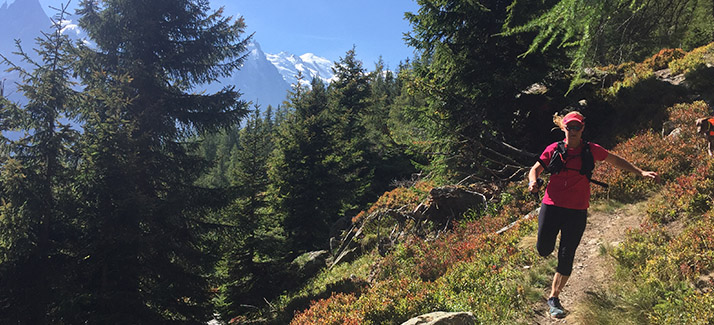A RUNNER'S GUIDE TO LONDON
There's no doubt about it, London is a big place, with loads of running potential. So how do you use one of the world's greatest urban environments to maximise our running?
Hayden Shearman, run coach and author of the Runner's Guide to London shares the 7 best workouts to add to your training schedule, and where to do them.

1. The 50-Minute Fartlek
‘Fartlek’ is Swedish for ‘speed play’. Begin your speed play with 10-20 minutes of light jogging, switching gears by running for 3.5 minutes at about your 10K race pace and then jogging for 90 seconds. Repeat this on-off pattern 6 times, totalling 30 minutes, before warming down with 10-20 minutes of jogging.
Don’t worry about measuring your speed on a GPS. Instead, do this over rolling terrain with varying surfaces underfoot to maintain the ‘play’ aspect of the fartlek
Where To Go:
- Horsenden Hill, Perivale: 3.5 miles
- Wimbledon Common: 7.8 miles
- Richmond Park (pictured): 7.25 miles
- Hainault Forest: 6 miles
- Petts Wood, Chislehurst: 4 miles

2. The Lazy Long Run
The weekly long run is a staple in any serious runner’s diet and is typically performed at a conversational pace. If you’re too out of breath to talk your fellow runners, then you’re running too fast!
Increase this long run by 10% or one mile each week and give yourself a shorter recovery week once a month.
Where To Go:
- Bushy Park, Teddington: 6.6 miles
- Thames Path (pictured): 44 miles from Hampton Court to Erith
- Regent’s Canal: 9.3 miles
- Ruislip Woods: 9 miles
- Epping Forest: 15+ miles

3. Hills for Breakfast
Running hills is speed work in disguise. Start off with a few easy hill runs to prepare your calves for the onslaught and then perform some fartlek runs over the hills. Finally, hunt out slopes specifically for hard running, such as 6×30 seconds up moderate slopes or 5×3 minutes up longer, gentler slopes. Jog back down for recovery.
Where To Go:
- Hampstead Heath (pictured): 8 miles
- Primrose Hill, Regent’s Park: 4 miles
- Greenwich Park: 2 miles
- Crystal Palace Park: 2.05 miles

4. The Recovery Run
The key to staying healthy in body and mind is to schedule plenty of easy recovery runs. Much like a long run, recovery runs should be ideally performed on soft surfaces like dirt, grass and gravel. Keep these short: 50 minutes max.
Where To Go:
- Eastbrookend Country Park, Dagenham: 3.2 miles
- Wanstead Flats and Park: 6.9 miles
- Fryent Country Park, Kingsbury: 2.3 miles
- Bedfont Lakes Country Park: 2 miles
- Hyde Park (pictured): 3 miles

5. Threshold Temp
After a 10-20-minute jogging warm-up, run for 30 minutes at a pace you could hold all-out for one hour.
This might be close to your 10K race pace, or for others closer to half marathon pace. It’s a pace that gets your body used to flushing out the fatigue that accumulates in your muscles when running fast.
This is a tough workout, so go with a friend and perform it somewhere flat, ideally with measured distance markers. Warm down with 10-20 minutes of jogging.
Where To Go:
- Hyde Park Serpentine (pictured): 2.06 miles
- Danson Park, Bexleyheath: 1.25 miles
- Paddington Branch, Grand Union Canal: 13 miles
- Hornchurch Country Park: 2.5 miles

6. VO2 Max Intervals
What pace could you handle for 10 minutes of running flat-out?
This mentally challenging tempo should be close to your VO2 max running pace: the speed at which your lungs begin to work at maximum intensity. Run this pace for multiple intervals on a flat, measured course with short recovery jogs in-between each effort.
For example, warm up and warm down with 15 minutes of jogging, and in the middle run 5x600m at your VO2 max pace with a 200m jog after each interval.
Where To Go:
You can do this workout at your local running track.

7. Strides
Strides are short, fast and controlled runs (not sprints) designed to develop efficient running technique. These are great to do barefoot on soft grass towards the end of an easy run.
Do 6×10 seconds or 3×30 seconds, with 60-90 seconds of jogging for recovery.
Where To Go:
- Parsloes Park, Dagenham (pictured): 2.5 miles
- Hampstead Heath Extension: 8 miles around Hampstead Heath
- Hanworth Park, Felltham: 1.75 miles
- Clapham Common: 2.8 miles
How To Find The Perfect Urban Running Spots Near You
SOFT FOR RECOVERY
Find a nearby park or common with soft dirt or grass trails where you can give your legs a break from constantly pounding the pavement.
HILLS FOR STRENGTH/CARDIO
Hills build strength and increase aerobic capacity. Be sure to include them regularly so that you don’t become a flatland mammal!
MEASURED FOR SPEED
SCENIC FOR INSPIRATION
Regularly hunt out new, exciting places to run and then test them in all four seasons. Even a new route a few miles from home is perfect for reigniting your passion for running.
RUN CLUB
Join us at one of our Run Clubs to give you the support and motivation you need to keep running throughout the city. Find your nearest Run Club.
You May Also Like:





